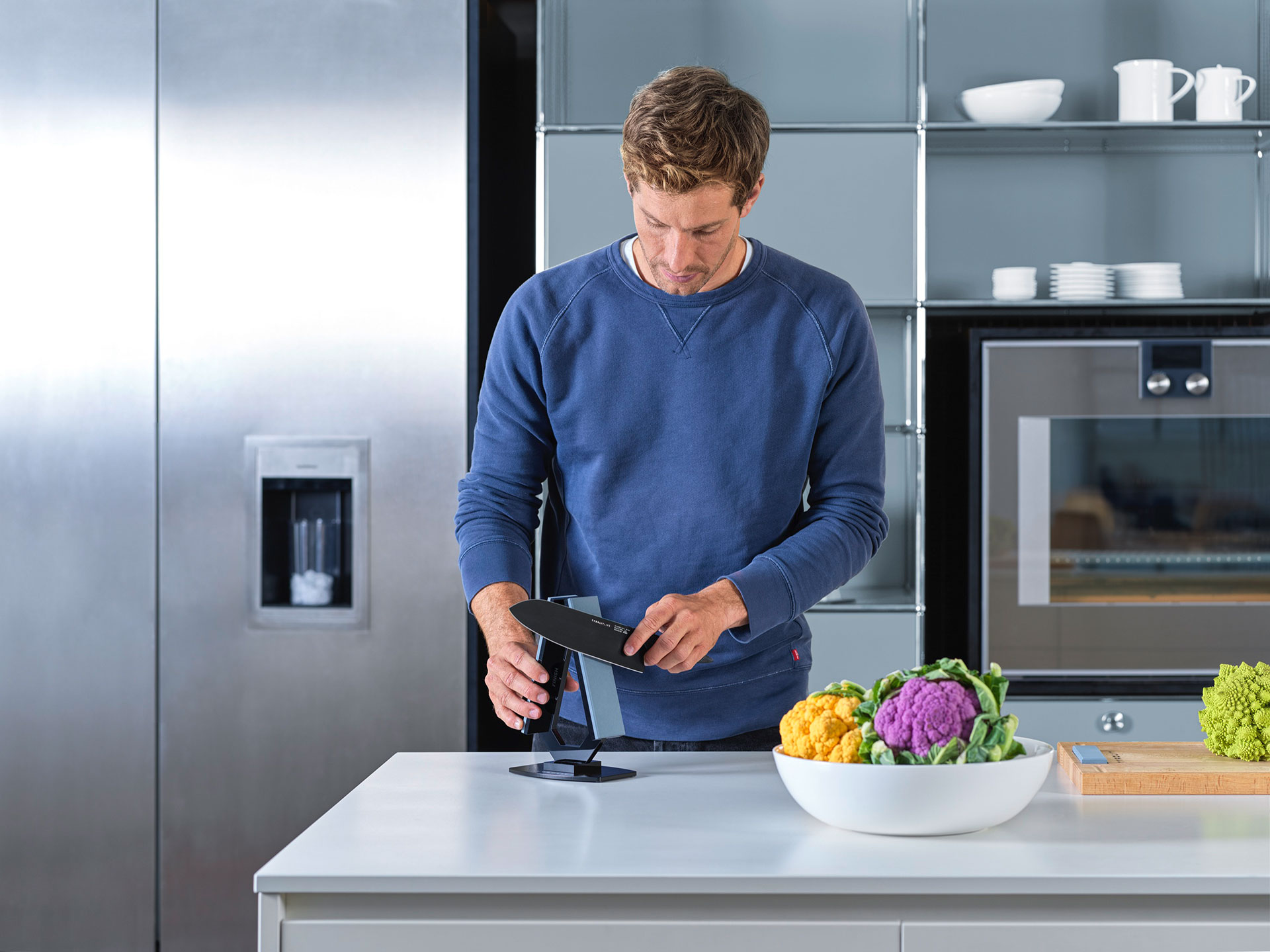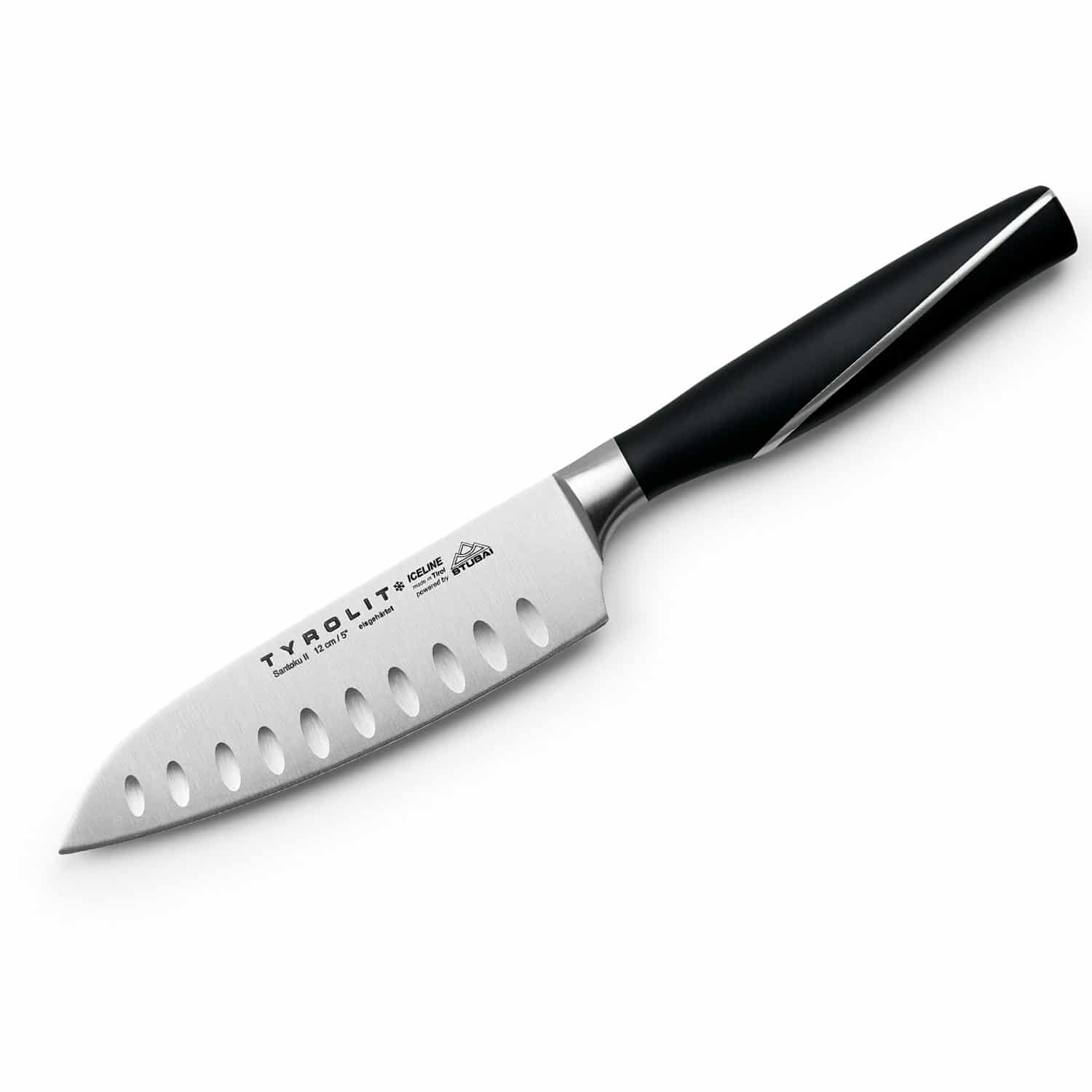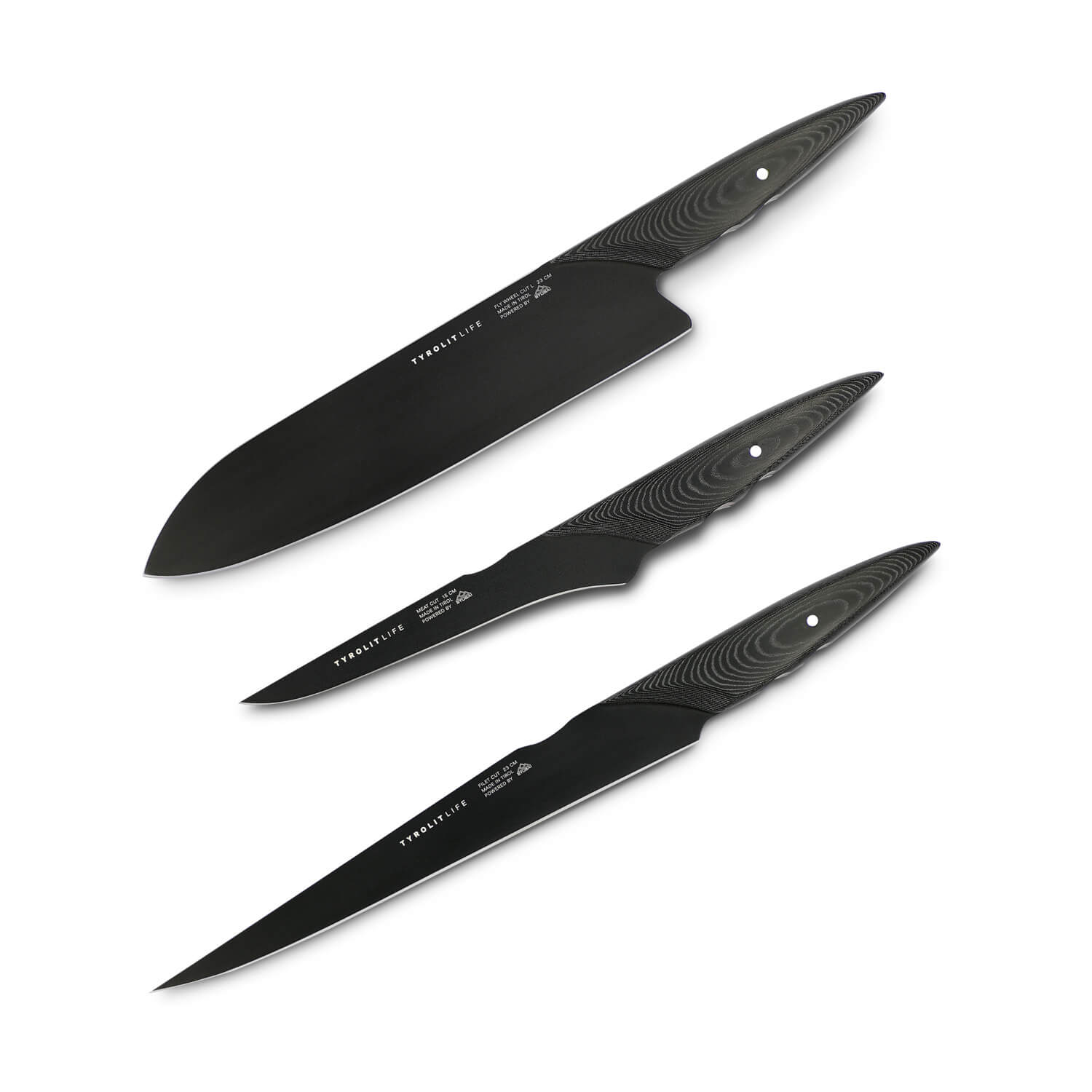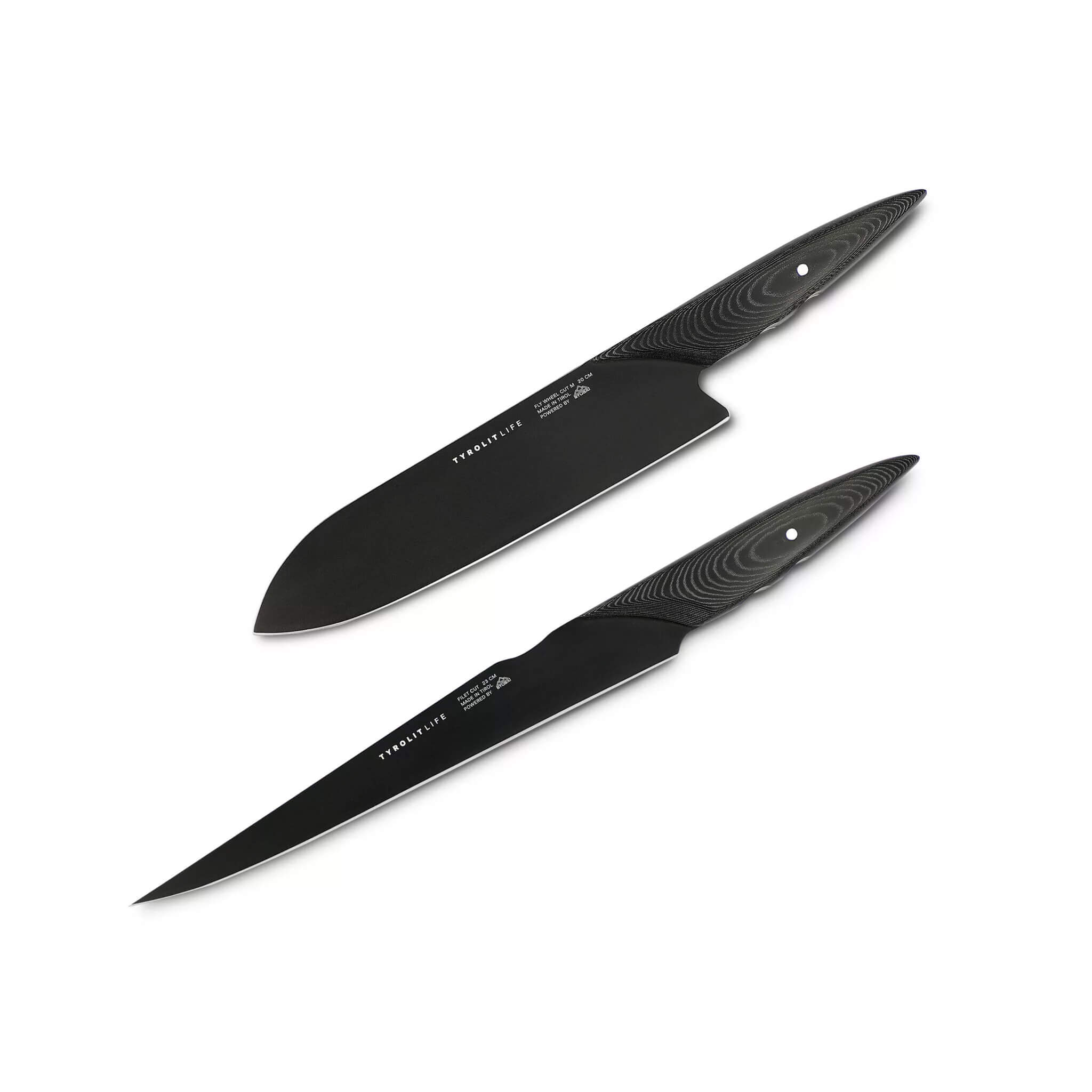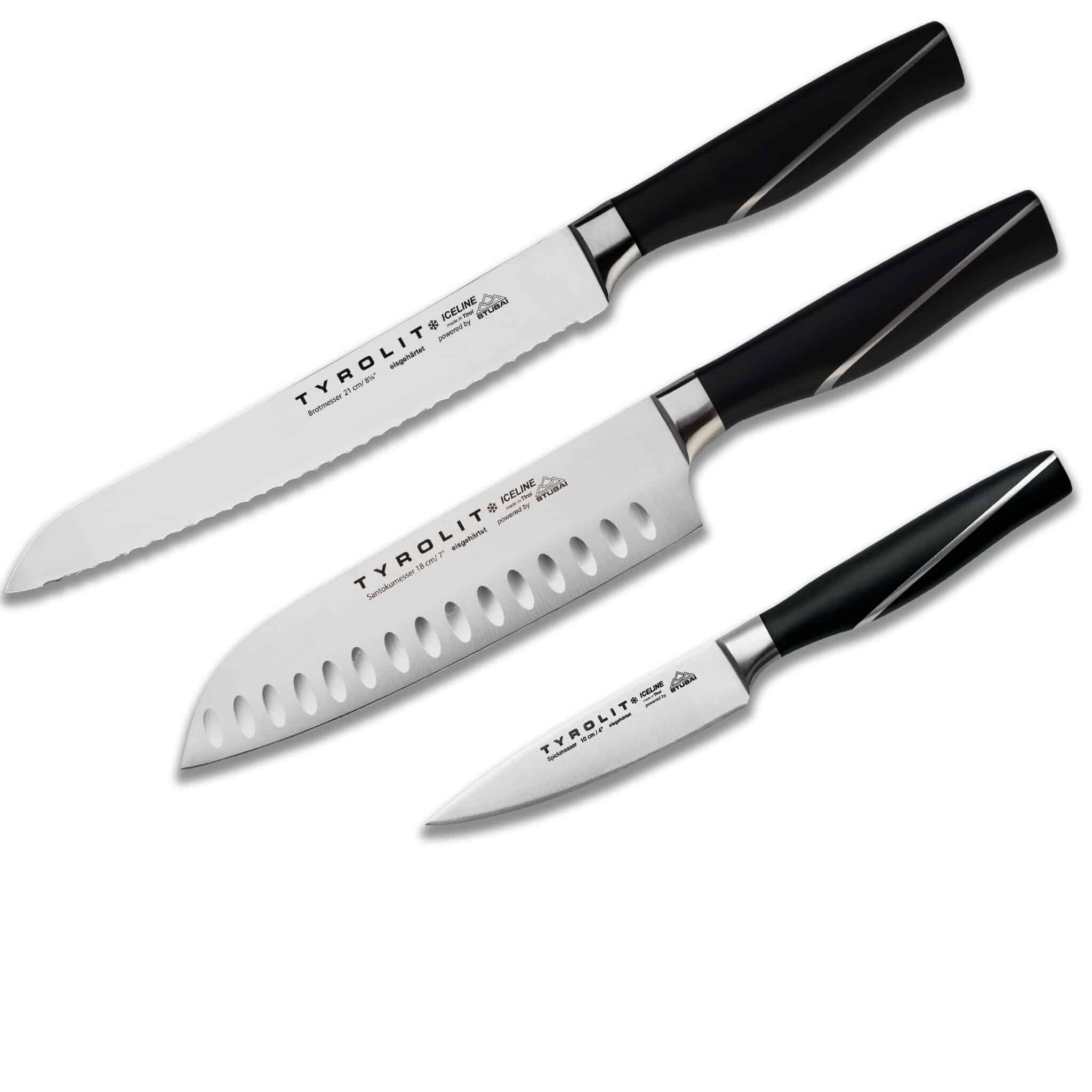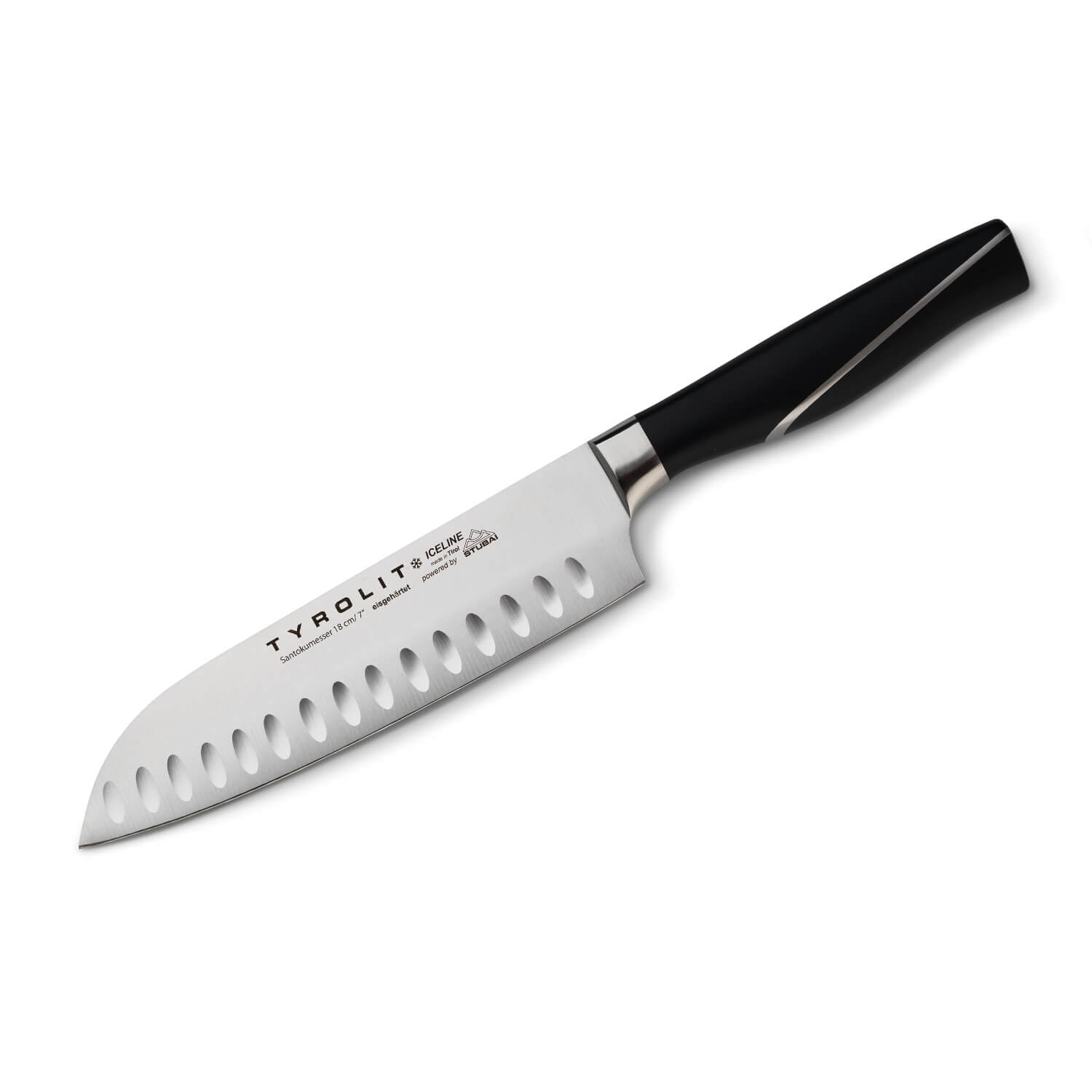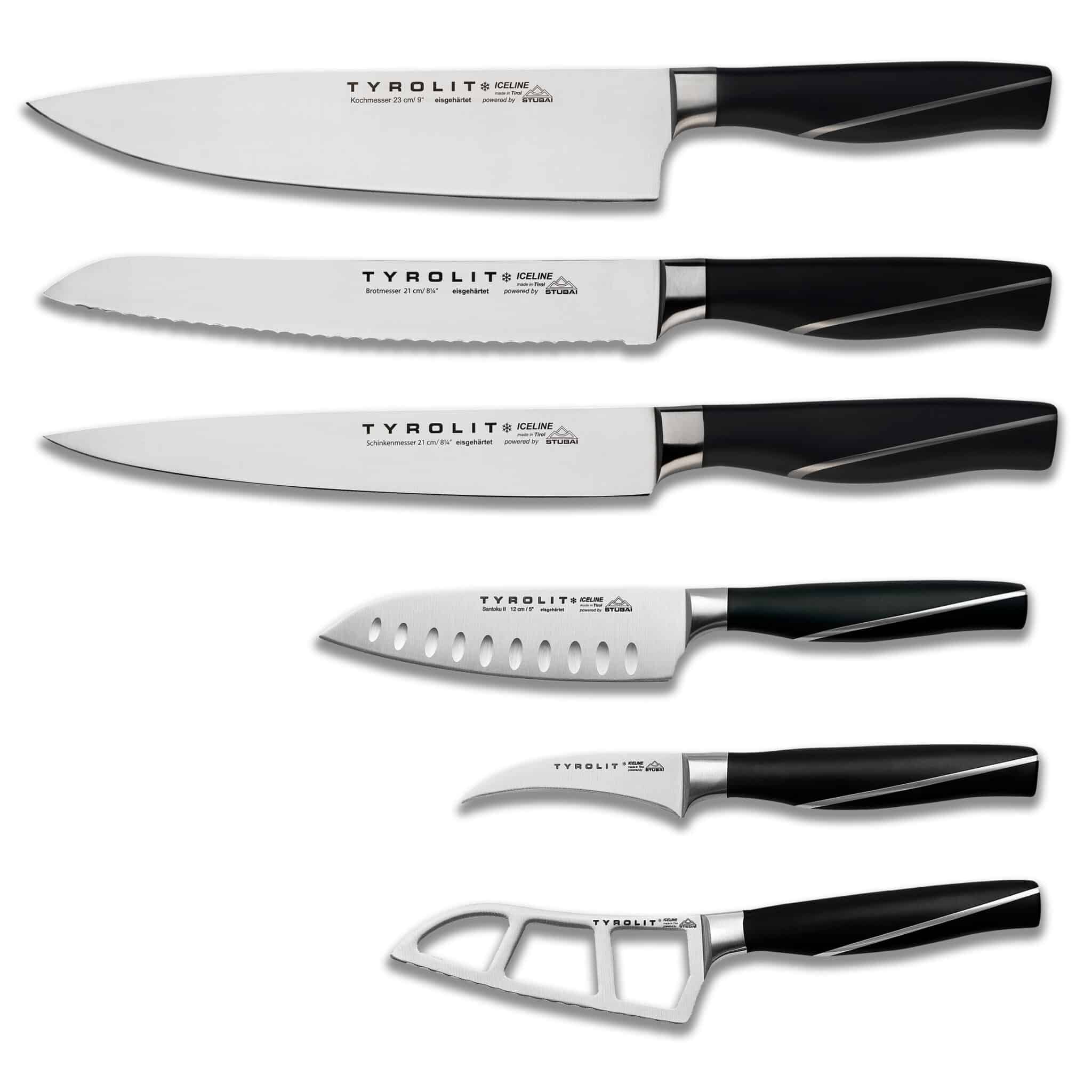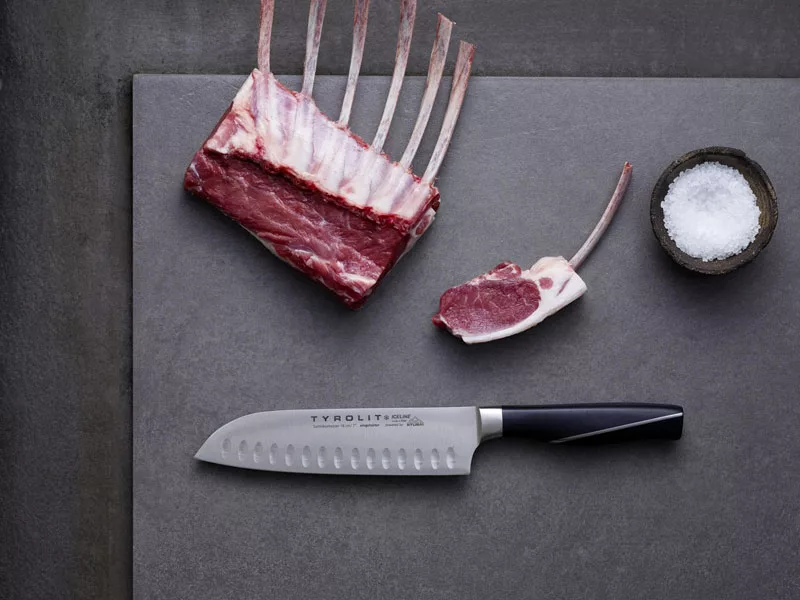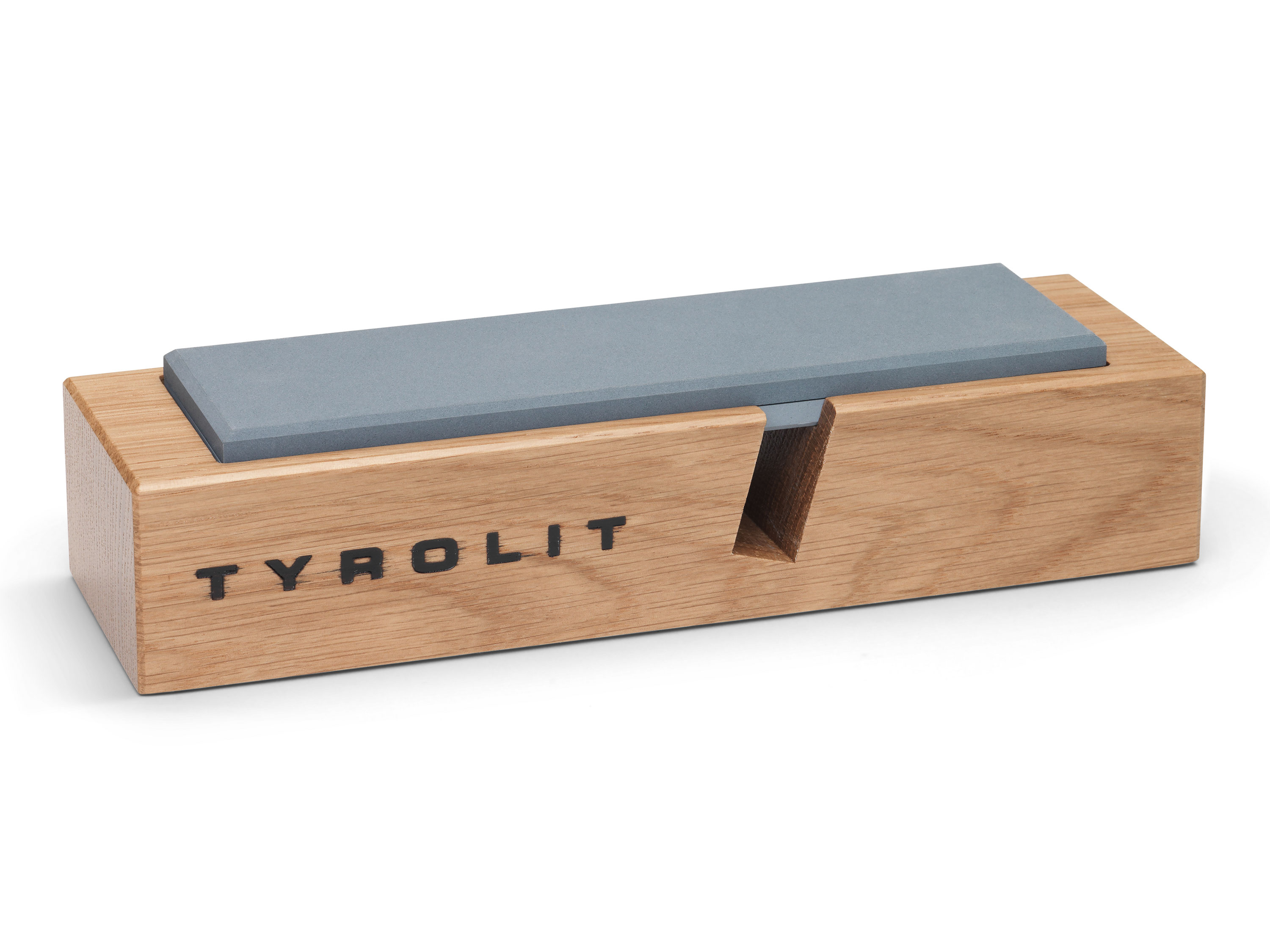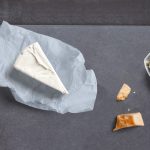Chef’s knife – all information about the Chef’s knife
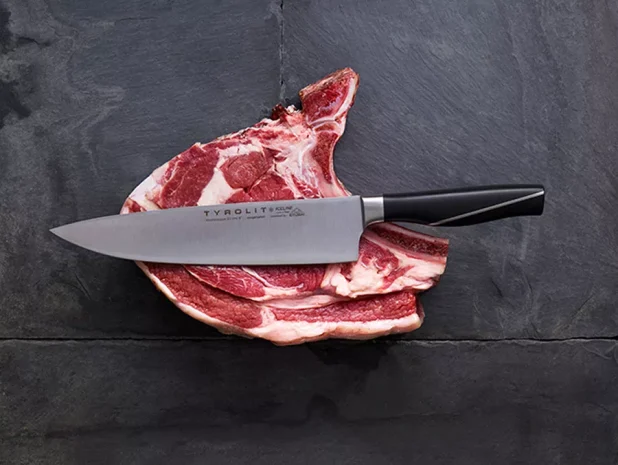
Any ambitious chef, whether amateur or professional, knows that a good chef’s knife is the heart of any well-equipped kitchen. It’s not just a simple tool, but the extended arm of the cook – the medium that turns ingredients into delicious dishes.
In the culinary world, there are a multitude of different chef’s knives – from the classic European chef’s knife, to the delicate Japanese santoku knife, and the sturdy Chinese Cai Dao. Each of these chef’s knives carries its own history, its unique purpose, and specific advantages.
But it is not only the purchase of a high-quality knife that is crucial. Proper care is at least as important. Sharpening, sanding and proper storage play a central role in ensuring the longevity and efficiency of your high-quality kitchen knives. A sharp knife not only reduces the risk of accidents, as it can slip less. It also increases the enjoyment of cooking.
Throughout this article, we will dive deeper into the fascinating world of cooking knives, providing you with essential information about the various types, materials, and care tips. This ensures that ambitious cooks can always be confident of having the right cooking knife at home and using and maintaining it in the best possible way.
Basic knife knowledge: What makes a good chef’s knife?
In addition to the vegetable knife and bread knife or meat knife, a good chef’s knife is part of the basic equipment in the kitchen. A high-quality chef’s knife is the result of a combination of high-quality materials, precise workmanship and ergonomic design.
But what exactly are the criteria that distinguish an ordinary from an outstanding chef’s knife?
Kitchen knives – The best tips and information
Whether beginner, amateur or professional chef – a high-quality kitchen knife is the heart of every kitchen. Because what can be more discouraging than having to work with a blunt knife every day? A sharp kitchen knife, on the other hand, is a real pleasure. Find out more!
Blade Materials
Choosing the material for the blade is critical to the performance and longevity of the knife. Stainless steel is a popular choice because of its robustness and corrosion resistance. It is easy to care for and offers good cutting durability. An alternative to this is stainless chrome steel, which is also used in some high-quality kitchen knives.
An alternative to such knives is the damask knife made of Damascus steel – a composite steel that is forged from various types of steel. This steel is not only known for its distinctive, wavy pattern, but also for its extraordinary sharpness and durability.
Ceramic knives, on the other hand, are extremely sharp and retain this sharpness even over a long period of time, but they are more susceptible to breakage and require special care. In particular, the sharpening and grinding should be carried out by experts.
The HRC (Rockwell hardness) provides information about the hardness of the steel. A higher HRC value usually means the knife will stay sharp longer, but it may also be more prone to breakage. It is important to find a good middle ground here.
Cutting properties of the chef’s knife
A sharp knife is not only more efficient, it is also safer. A knife with high edge retention stays sharper longer, reducing the need for frequent sharpening. Hollows on the blade (small indentations) help to prevent the food from sticking to the blade.
Handle and balance
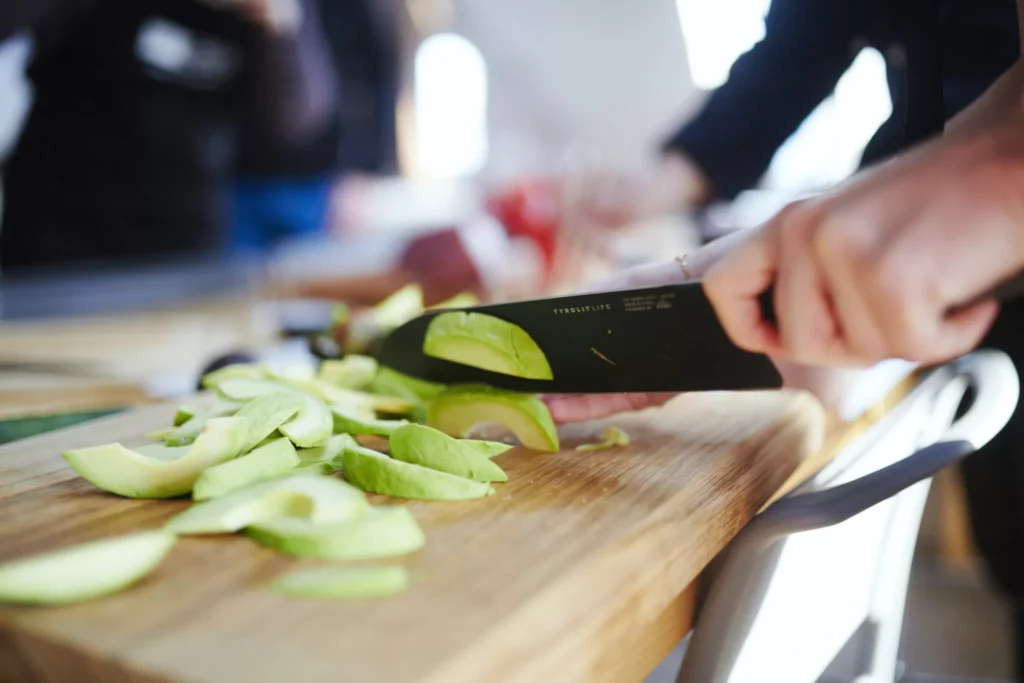
A well-balanced knife is not only comfortable in the hand, it also increases precision when cutting. The weight of the knife should match the size of the hand and the preferred cutting technique. Excessively heavy knives can be tiring during long cooking sessions, while light knives do not provide enough pressure for certain jobs.
The handle of a knife can be made of different materials, from plastic to wood to stainless steel. Each material has its own advantages and disadvantages in terms of grip, hygiene and durability.
What are the differences in the world of chef’s knives?
While the chef’s knife appears universal in its basic form, chef’s knives vary in shape, length and material depending on which part of the world they come from. For example, a traditional European chef’s knife differs significantly from its counterparts from Japan or China.
These differences often stem from centuries-long cooking traditions, where the knives were specifically designed for preparing national dishes. Whether as a utility knife, a chef’s knife, or a kitchen knife, these tools are named purposefully. They reflect the culinary history and culture of their countries of origin.
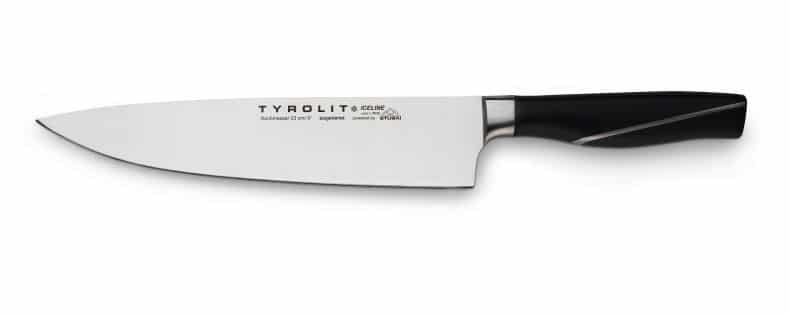

The classic chef’s knife – Chef’s knife
Originally from Europe, the classic chef’s knife is characterized by a wide blade that tapers towards the tip. The average blade length is between 20 and 26 cm. It is versatile and is excellent for slicing, chopping, and dicing vegetables, meat, and fish.
Santoku Knife
The Santoku knife is well-known to many because of its hollow edge. The Santoku, meaning “three virtues,” originates from Japan and is celebrated for its versatile use in slicing meat, fish, and vegetables. It features a shorter, wider blade, typically ranging from 13 to 20 cm.
Japanese Kitchen Knives
In addition to the Santoku, there are a number of other specialized Japanese knives, such as the Gyuto (a Japanese chef's knife) or the Nakiri (especially for vegetables). They are characterised by high sharpness and specialised areas of application.
Chinese chef's knife
Visually, it often resembles a hatchet, which is why the chef’s knife is also frequently referred to as the Chinese cleaver, or "Cai Dao" (菜刀) in Chinese. With its rectangular shape and a blade length ranging between 18 and 22 cm, it is perfectly suited for chopping vegetables and meat. The broad blade can also be used to transfer ingredients to a pot or pan.
Cutting Technique - The Rocking Cut with the Classic Chef's Knife
The rocking cut is one of the fundamental cutting techniques used when working with a chef's knife. The name of the technique suggests this: the knife is guided in a rocking motion over the food being cut, where the front tip of the knife almost always remains in contact with the cutting board.
This cutting style harmoniously combines cutting pressure and cutting motion, enabling high cutting efficiency with minimal effort. Particularly for chopping herbs or finely slicing vegetables, the rocking cut is an excellent technique.
For an effective rocking cut, it is crucial that the holding hand – the hand holding the food – acts as a guide for the knife. The fingers of this hand should be slightly curved, allowing the knife's blade to glide safely along the knuckles. The finger nearest to the knife pulls back during the cutting motion, thus setting the distance for the next cut. This technique not only ensures precise cuts but also protects the fingers from injuries.
It is not only important to understand the technique of the rocking cut, but also to practice it regularly. Because only through practice does one become more skilled and faster, which ultimately leads to a better cooking experience
The Meat Knife – A Comprehensive Overview
A meat knife is an indispensable kitchen tool, specifically developed for slicing, carving, and segmenting meat. Discover what's important in this article!
The Right Cutting Board for Your Kitchen Knives
Cutting pads, such as in the form of cutting boards, are essential in any kitchen. They protect not only the work surface, but also the knife blade from wear and tear.
Plastic boards are lightweight and dishwasher safe, but tend to have grooves that need to be cleaned thoroughly.
Wooden cutting boards have antibacterial properties and protect the knife blades, so that they remain sharper. The cutting board from Tyrolit Life has also integrated a grindstone with two grits. So you always have a sharp chef's knife at hand.
Care and Storage of Your Chef's Knife
With proper care and handling, a high-quality chef's knife can be a faithful companion in the kitchen for many years. Therefore, it's essential to care for and clean your knives! It is not merely a tool, but an investment in your culinary possibilities. Thus, it is crucial to properly maintain this instrument.
Why regular sharpening of your chef's knife is important
Knives lose their sharpness over time, especially when used regularly. A blunt knife is not only inefficient, but also more dangerous as it slips off more easily.
Regular sharpening ensures that your knife is always ready for use and that you can make precise cuts. Various tools such as sharpening steel, sharpening stones, or knife sharpeners are used here. Tyrolit Life offers knife sharpeners with an integrated sharpening angle of 15°, which delivers optimal sharpness and precision. This accessory makes sharpening knives at home effortlessly.
Types of Whetstones – Materials, Shapes, and Uses
Choosing the right whetstone or sharpening stone is anything but trivial: it is only by regularly sharpening knives that they retain their sharpness. In order to provide an overview here, we will introduce you to different types of grinding stones in this article. In addition, we will show you how we at Tyrolit, as long-standing abrasive experts, have further developed the classic sharpening stone into our innovative knife sharpeners. Read more!
Handwash vs. Dishwasher: Which is Better?
Although many modern chef's knives are considered dishwasher safe, many experts recommend hand washing. In the dishwasher, knives can be damaged by the hard water and the sharp detergents.
In addition, there is a risk that the knives will hit other utensils and damage the blade. A gentle hand wash with mild soap preserves the sharpness and quality of your knife.
Secure storage options for a longer lifespan
The correct storage of the chef's knife contributes significantly to its longevity.
If you want to keep your knife in a drawer, use a blade guard. This not only prevents injuries, but also protects the blade of the knife.
Your knives remain optimally protected on a magnetic strip or in a wooden knife block. It protects the blade from direct contact with other objects, which reduces the risk of damage.
At Tyrolit Life, you will find a magnetic knife block where you can also store your previously purchased kitchen knives with care. Additionally, the knife block features an integrated knife sharpener. This allows you to begin every meal with perfectly maintained and sharp knives.
By adhering to these care and storage tips, you can ensure that your chef's knife will serve you reliably for many years. At Tyrolit Life, you can purchase a high-quality chef's knife.

